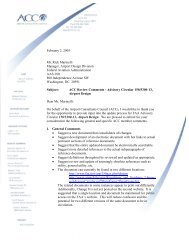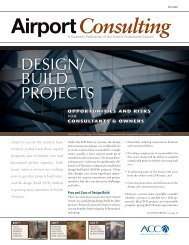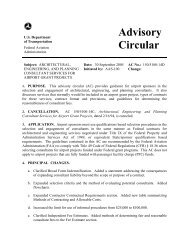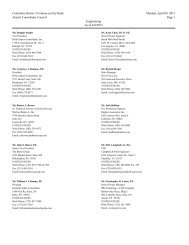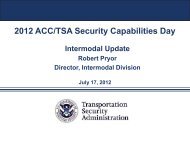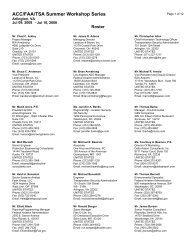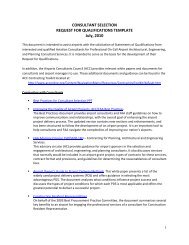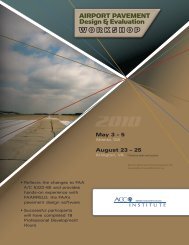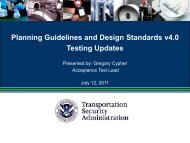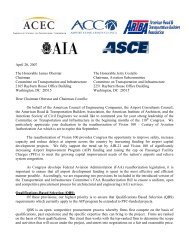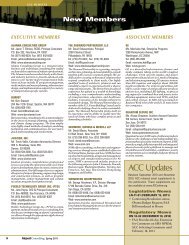Innovative Taxiway Design - ACConline.org
Innovative Taxiway Design - ACConline.org
Innovative Taxiway Design - ACConline.org
Create successful ePaper yourself
Turn your PDF publications into a flip-book with our unique Google optimized e-Paper software.
Fall 2012<br />
Consulting<br />
A Publication of the Airport Consultants Council<br />
<strong>Innovative</strong> <strong>Taxiway</strong> <strong>Design</strong><br />
USING MODELING TO<br />
COMPLY WITH THE FAA’S NEW<br />
PROPOSED TAXIWAY DESIGN GROUP<br />
By Fin B. Bonset, M.Sc., Simtra Americas<br />
The Federal Aviation<br />
Administration’s (FAA)<br />
Airport <strong>Design</strong> Advisory<br />
Circular (AC) 150/5300-13<br />
is considered a “near-holy”<br />
document for anyone involved in airport<br />
development in the United States. Airport<br />
planners and engineers consider it to be the<br />
go-to manual in designing airside facilities.<br />
Over the years, the document has evolved<br />
through frequent amendments and addendums<br />
to account for the ever-changing<br />
airport planning and design process in order<br />
to reference industry trends such as new<br />
aircraft types and concerns for operational<br />
safety. There is a lot of buzz in the industry<br />
about the FAA’s complete re-write of the<br />
AC, which is expected to be released this<br />
fall. So what is in store for airport planners<br />
and designers<br />
The latest and greatest iteration of the document<br />
has the designation AC 150/5300-<br />
13A. The “Alpha” designation at the end is<br />
quite appropriate based on one of its many<br />
definitions: “being the most prominent,<br />
talented, or aggressive item in a group.”<br />
The current changes are quite profound,<br />
prominent, and certainly more aggressive,<br />
when compared to the current edition of<br />
the document.<br />
NEW TAXIWAY DESIGN GROUP<br />
One of the most significant changes in the<br />
new AC pertains to new taxiway design<br />
criteria. A new proposed “<strong>Taxiway</strong> <strong>Design</strong><br />
Group” (TDG) will replace the current,<br />
long-accepted way of doing business under<br />
the trusted Airplane <strong>Design</strong> Group (ADG).<br />
The main difference is that TDG incorporates<br />
elements related to actual aircraft<br />
movements of a specific taxiing aircraft,<br />
instead of the current ADG wingspan and<br />
tail height requirements which are more<br />
related to safety clearances to objects or<br />
other aircraft. The TDG will be based on<br />
Main Gear Width (MGW) combined with<br />
Cockpit to Main Gear (CMG) distance.<br />
Furthermore, all taxiway fillet design<br />
will now be based on maintaining the<br />
aircraft’s cockpit over the centerline,<br />
which has essentially eliminated the old<br />
judgmental over-steering concept from<br />
See INNOVATIVE on page 16<br />
page 4<br />
SPECIAL FEATURE:<br />
MINIMIZING THE<br />
INSIDER THREAT<br />
WITH AIRPORT<br />
WORKER ID<br />
MANAGEMENT<br />
page 6<br />
CONSULTANT<br />
PERSPECTIVE:<br />
EDUCATING THE<br />
LOCAL AIRPORT<br />
POLICY MAKERS<br />
page 12<br />
PHOTO REVIEW OF<br />
THE ACC SECURITY<br />
CAPABILITIES DAY<br />
AND SUMMER<br />
WORKSHOP SERIES
ACC MEMBERS<br />
And the Winner Is…<br />
INNOVATIVE continued from page 1<br />
AECOM has been awarded an $85 million construction management contract for the<br />
new Midfield Terminal Complex at Abu Dhabi International Airport. AECOM will<br />
work with Hill International as the prime sub-consultant and take on responsibility<br />
for many aspects of the construction of the 7.5-million-square-foot Midfield Terminal<br />
Building as well as the required associated airside and landside infrastructure. The<br />
terminal, which will be able to handle more than 30 million passengers and will have<br />
sufficient piers to accommodate 65 aircraft including the Airbus A380, is scheduled to<br />
open during 2017.<br />
C&S COMPANIES received a platinum 2012 Engineering Excellence Award from the<br />
ITHACA<br />
TOMPKINS REGIONAL AIRPORT sustainable master plan that was featured as a case<br />
study in the Fall 2009 issue of AirportConsulting. C&S was the consultant for the country’s<br />
first FAA-funded master plan that integrates sustainability principles throughout<br />
the planning process. Because this project still had to meet the requirements of the<br />
FAA for master plans, the team had to create a new model for airport master planning<br />
that maintained requirements, while also integrating sustainability elements. One new<br />
aspect on the project was a baseline assessment of 11 sustainability categories. Data<br />
was gathered and analyzed for each category, and areas of weakness and strength were<br />
identified. The results were used to set goals and objectives to guide decisions about<br />
how to meet upcoming facility needs. This project was responsible for the FAA’s initiation<br />
of a sustainability planning pilot program at 10 airports nationwide.<br />
HNTB CORP. was awarded $7 million to complete a series of safety improvements<br />
to one of the south airfield’s runways and a pair of taxiways at Los Angeles<br />
International Airport. The arrangement, approved by the Los Angeles Board of<br />
Airport Commissioners, also calls for making improvements to the eastern cargo apron<br />
of the Century Cargo Complex, according to an LAX report. The Federal Aviation<br />
Administration called for the airfield improvements at LAX so that the airport can meet<br />
a new set of safety standards set to go into effect in 2015.<br />
LANDRUM & BROWN has been selected to partner with the Civil Aviation Management<br />
Institute of China (CAMIC) to provide five years of Executive Management Training<br />
for mid-level airport managers from China. The partnership was announced at a ceremony<br />
officiated by Civil Aviation Authority of China (CAAC) Deputy Administrator<br />
Xia Xinghua and attended by Director General Qin Zhanggao of the CAAC Airport<br />
<br />
The three week overseas training will follow a 10-week domestic training curriculum,<br />
and will focus on various aspects of airport planning, air traffic operations and strategic<br />
management issues, including sustainability, security, safety, and customer service<br />
quality. The training will take place twice a year and will involve participation by various<br />
member companies of the ACP, and tours of airport facilities and operations. As<br />
members of the US-China Aviation Cooperation Program (ACP), L&B will also include<br />
other industry experts on key topics of safety, security and IT management to ensure<br />
that the most current methods and technology are represented.<br />
airport design literature. To compensate<br />
for the overall elimination of judgmental<br />
over-steering (which is basically a way to<br />
reduce fillet pavement), the turning radii<br />
for each design group have been decreased<br />
significantly, i.e. the old ADG-VI fillet<br />
radius of 170 feet has been reduced and<br />
changed in designation to “TDG-7” with<br />
only 130-feet of radius. And yes, that<br />
smaller radius works just fine, even for<br />
such critical long wheel-based aircraft as<br />
the Airbus A340 and A380.<br />
However, those seeing the drawings for<br />
the first time may think the new TDG<br />
fillet schematic designs look quite “funny.”<br />
In reality, when testing the new radii with<br />
simulation software, the new taxiway fillet<br />
<br />
only does it work from an operational<br />
point of view, but it also saves on the<br />
amount of fillet pavement required by as<br />
much as 5-15 percent, depending on which<br />
TDG is being used. And, as we all know,<br />
less pavement equals less cost.<br />
COST SAVINGS THROUGH<br />
TECHNOLOGY<br />
As noted above, the FAA seems to<br />
have taken a new and positive stance<br />
on the further allowance of pavement<br />
reduction and cost saving beyond its<br />
new TDG concept. But there is another<br />
important aspect to the AC: “The use of<br />
Computer Aided <strong>Design</strong> (CAD) in lieu<br />
of Table 4-3 through Table 4-8 to model<br />
aircraft movements is acceptable and<br />
may be necessary for intersections with<br />
nonstandard angles.” (Tables 4-3 through<br />
4-8 are all of the new TDG tables with<br />
16 Consulting, Fall 2012
COVER STORY<br />
ACC Weighs in<br />
on New Airport<br />
<strong>Design</strong> AC<br />
the fillet dimensions and radii). This is<br />
revolutionary. Based on this small literary<br />
excerpt, it appears that the FAA is keeping<br />
up with the times. “Modeling” is the key<br />
word here, which is becoming more and<br />
more prevalent in today’s fast-paced and<br />
graphics-hungry airport design world. Thus,<br />
if an airport operator/representative has<br />
the means to successfully model a taxiway<br />
fillet design based on actual aircraft gear<br />
movements while adhering to new FAA<br />
TDG criteria, it can reduce the area of<br />
pavement to the most optimal amount.<br />
What types of tools are available to<br />
enhance taxiway fillet design CAD-based<br />
simulation software can provide complete<br />
simulation to handle a large variety of<br />
planning and operational aspects, including<br />
accurate fillet design. This software<br />
operates based on the actual movement and<br />
speed of a specific aircraft’s nose gear and<br />
main gear.<br />
So how does it work The designer can<br />
choose a point on the aircraft to follow a<br />
specific curve (“cockpit over the centerline”<br />
can be chosen), limit the aircraft’s nose<br />
gear steering angle (to the FAA’s 50-degree<br />
limit), and have the software follow a line<br />
of any specified radius until a stop-point is<br />
designated. The software then creates an<br />
offset line (in color) from the outer edge<br />
of the actual aircraft main gear tire, which<br />
is based on the FAA (or ICAO) main-gear<br />
clearance requirement of that particular<br />
design group aircraft. Once complete, a<br />
movie can be created from the simulation.<br />
Airports and consultants in other parts of<br />
the world have been using such software<br />
for years in order to save on pavement costs<br />
and have been relying on the critical aircraft<br />
instead of the maximum design group<br />
requirements. In the U.S. however, the<br />
maximum AC 5300-13 ADG requirements<br />
have been promoted, thus resulting in more<br />
pavement than needed. With the new AC,<br />
this is no longer the case. The reduced fillet<br />
requirements of the new <strong>Taxiway</strong> <strong>Design</strong><br />
Group, coupled with the allowable usage<br />
of software, will enable consultants to<br />
provide not only airports, but the FAA and<br />
the airport industry as a whole with cost<br />
savings and operational efficiency while<br />
maintaining all required safety clearances.<br />
In conclusion, the FAA has come up with<br />
a concept that pertains to actual aircraft<br />
movement based taxiway design. With<br />
the involvement of the industry, the FAA<br />
has been open to new concepts which are<br />
more realistic. The new AC, based on<br />
actual aircraft modeling, appears to be a<br />
solid solution for future airport design and<br />
overall system cost savings. As with all new<br />
things, the industry may take some time<br />
to get used to the new standards, but then<br />
again, the tools for implementation already<br />
exist.<br />
ACC was invited by the FAA to provide<br />
comments on the new draft Airport<br />
<strong>Design</strong> AC 150/5300-13A, “Airport<br />
<strong>Design</strong>.” ACC members participated<br />
in a workshop sponsored by the FAA<br />
in April to review new concepts and<br />
requirements under the draft AC.<br />
ACC also solicited comments from<br />
members and submitted over 90<br />
pages of suggestions to the FAA<br />
(a copy of the comment letter<br />
can be found on the ACC website<br />
www.<strong>ACConline</strong>.<strong>org</strong>).<br />
Some of the major changes provided<br />
in the new Airport <strong>Design</strong> AC and<br />
discussed in ACC’s comments include<br />
the following:<br />
» The <strong>Taxiway</strong> <strong>Design</strong> Group<br />
(TDG) concept<br />
» Better explanation and<br />
examples on Declared<br />
Distances<br />
» New electronic <strong>Design</strong> Group<br />
Tables<br />
ACC also asked how the new design<br />
standards will be implemented,<br />
particularly for projects that are<br />
currently underway or have already<br />
been designed. ACC will be sponsoring<br />
webinars to inform the industry on<br />
the major changes contained in the<br />
new AC — refer to the ACC website<br />
for more information.<br />
www.<strong>ACConline</strong>.<strong>org</strong><br />
17



